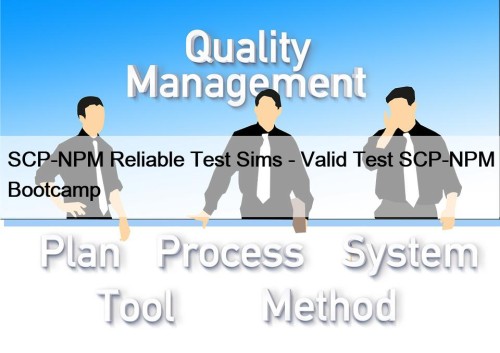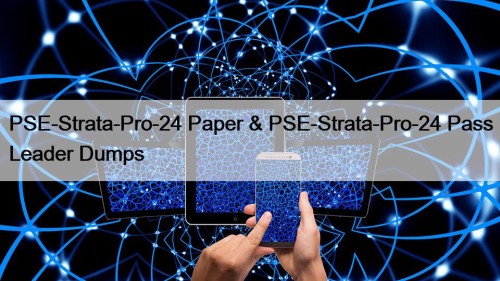Most Popular
 SCP-NPM Reliable Test Sims - Valid Test SCP-NPM Bootcamp
SCP-NPM Reliable Test Sims - Valid Test SCP-NPM Bootcamp
BTW, DOWNLOAD part of Prep4sureExam SCP-NPM dumps from Cloud Storage: ...
 SCP-NPM Valid Dumps Free - SCP-NPM Real Question
SCP-NPM Valid Dumps Free - SCP-NPM Real Question
BONUS!!! Download part of 2Pass4sure SCP-NPM dumps for free: https://drive.google.com/open?id=18-PLHPvgvaAMGuJNrIHgfXaIyLvCZwmCBest ...
 PSE-Strata-Pro-24 Paper & PSE-Strata-Pro-24 Pass Leader Dumps
PSE-Strata-Pro-24 Paper & PSE-Strata-Pro-24 Pass Leader Dumps
A considerable amount of effort goes into our products. So ...



PSE-Strata-Pro-24 Paper & PSE-Strata-Pro-24 Pass Leader Dumps

A considerable amount of effort goes into our products. So in most cases our PSE-Strata-Pro-24 exam study materials are truly your best friend. On one hand, our PSE-Strata-Pro-24 learning guide is the combination of the latest knowledge and the newest technology, which could constantly inspire your interest of study. On the other hand, our PSE-Strata-Pro-24 test answers can predicate the exam correctly. Therefore you can handle the questions in the real exam like a cork. Through highly effective learning method and easily understanding explanation, you will pass the PSE-Strata-Pro-24 Exam with no difficulty. Our slogans are genuinely engraving on our mind that is to help you pass the PSE-Strata-Pro-24 exam, and ride on the crest of success!
Palo Alto Networks PSE-Strata-Pro-24 Exam Syllabus Topics:
| Topic | Details |
|---|---|
| Topic 1 |
|
| Topic 2 |
|
| Topic 3 |
|
| Topic 4 |
|
PSE-Strata-Pro-24 Pass Leader Dumps | PSE-Strata-Pro-24 New Dumps Pdf
Under the dominance of knowledge-based economy, we should keep pace with the changeable world and renew our knowledge in pursuit of a decent job and higher standard of life. In this circumstance, possessing a PSE-Strata-Pro-24 certification in your pocket can totally increase your competitive advantage in the labor market and make yourself distinguished from other job-seekers. Therefore our PSE-Strata-Pro-24 Study Guide can help you with dedication to realize your dream. And only after studying with our PSE-Strata-Pro-24 exam questions for 20 to 30 hours, you will be able to pass the PSE-Strata-Pro-24 exam.
Palo Alto Networks Systems Engineer Professional - Hardware Firewall Sample Questions (Q45-Q50):
NEW QUESTION # 45
A systems engineer should create a profile that blocks which category to protect a customer from ransomware URLs by using Advanced URL Filtering?
- A. Ransomware
- B. High Risk
- C. Command and Control
- D. Scanning Activity
Answer: A
Explanation:
When configuring Advanced URL Filtering on a Palo Alto Networks firewall, the "Ransomware" category should be explicitly blocked to protect customers from URLs associated with ransomware activities.
Ransomware URLs typically host malicious code or scripts designed to encrypt user data and demand a ransom. By blocking the "Ransomware" category, systems engineers can proactively prevent users from accessing such URLs.
* Why "Ransomware" (Correct Answer A)?The "Ransomware" category is specifically curated by Palo Alto Networks to include URLs known to deliver ransomware or support ransomware operations.
Blocking this category ensures that any URL categorized as part of this list will be inaccessible to end- users, significantly reducing the risk of ransomware attacks.
* Why not "High Risk" (Option B)?While the "High Risk" category includes potentially malicious sites, it is broader and less targeted. It may not always block ransomware-specific URLs. "High Risk" includes a range of websites that are flagged based on factors like bad reputation or hosting malicious content in general. It is less focused than the "Ransomware" category.
* Why not "Scanning Activity" (Option C)?The "Scanning Activity" category focuses on URLs used in vulnerability scans, automated probing, or reconnaissance by attackers. Although such activity could be a precursor to ransomware attacks, it does not directly block ransomware URLs.
* Why not "Command and Control" (Option D)?The "Command and Control" category is designed to block URLs used by malware or compromised systems to communicate with their operators. While some ransomware may utilize command-and-control (C2) servers, blocking C2 URLs alone does not directly target ransomware URLs themselves.
By using the Advanced URL Filtering profile and blocking the "Ransomware" category, the firewall applies targeted controls to mitigate ransomware-specific threats.
NEW QUESTION # 46
What are two methods that a NGFW uses to determine if submitted credentials are valid corporate credentials? (Choose two.)
- A. WMI client probing
- B. Domain credential filter
- C. Group mapping
- D. LDAP query
Answer: B,D
Explanation:
* LDAP Query (Answer B):
* Palo Alto Networks NGFWs can queryLDAP directories(such as Active Directory) to validate whether submitted credentials match the corporate directory.
* Domain Credential Filter (Answer C):
* TheDomain Credential Filterfeature ensures that submitted credentials are checked against valid corporate credentials, preventing credential misuse.
* Why Not A:
* Group mappingis used to identify user groups for policy enforcement but does not validate submitted credentials.
* Why Not D:
* WMI client probingis used for user identification but is not a method for validating submitted credentials.
References from Palo Alto Networks Documentation:
* Credential Theft Prevention
NEW QUESTION # 47
Which three descriptions apply to a perimeter firewall? (Choose three.)
- A. Network layer protection for the outer edge of a network
- B. Guarding against external attacks
- C. Securing east-west traffic in a virtualized data center with flexible resource allocation
- D. Power utilization less than 500 watts sustained
- E. Primarily securing north-south traffic entering and leaving the network
Answer: A,B,E
Explanation:
Aperimeter firewallis traditionally deployed at the boundary of a network to protect it from external threats.
It provides a variety of protections, including blocking unauthorized access, inspecting traffic flows, and safeguarding sensitive resources. Here is how the options apply:
* Option A (Correct):Perimeter firewalls providenetwork layer protectionby filtering and inspecting traffic entering or leaving the network at the outer edge. This is one of their primary roles.
* Option B:Power utilization is not a functional or architectural aspect of a firewall and is irrelevant when describing the purpose of a perimeter firewall.
* Option C:Securing east-west traffic is more aligned withdata center firewalls, whichmonitor lateral (east-west) movement of traffic within a virtualized or segmented environment. A perimeter firewall focuses on north-south traffic instead.
* Option D (Correct):A perimeter firewall primarily securesnorth-south traffic, which refers to traffic entering and leaving the network. It ensures that inbound and outbound traffic adheres to security policies.
* Option E (Correct):Perimeter firewalls play a critical role inguarding against external attacks, such as DDoS attacks, malicious IP traffic, and other unauthorized access attempts.
References:
* Palo Alto Networks Firewall Deployment Use Cases: https://docs.paloaltonetworks.com
* Security Reference Architecture for North-South Traffic Control.
NEW QUESTION # 48
The PAN-OS User-ID integrated agent is included with PAN-OS software and comes in which two forms?
(Choose two.)
- A. Windows-based agent
- B. GlobalProtect agent
- C. Integrated agent
- D. Cloud Identity Engine (CIE)
Answer: A,C
Explanation:
User-ID is a feature in PAN-OS that maps IP addresses to usernames by integrating with various directory services (e.g., Active Directory). User-ID can be implemented through agents provided by Palo Alto Networks. Here's how each option applies:
* Option A: Integrated agent
* The integrated User-ID agent is built into PAN-OS and does not require an external agent installation. It is configured directly on the firewall and integrates with directory services to retrieve user information.
* This is correct.
* Option B: GlobalProtect agent
* GlobalProtect is Palo Alto Networks' VPN solution and does not function as a User-ID agent.
While it can be used to authenticate users and provide visibility, it is not categorized as a User-ID agent.
* This is incorrect.
* Option C: Windows-based agent
* The Windows-based User-ID agent is a standalone agent installed on a Windows server. It collects user mapping information from directory services and sends it to the firewall.
* This is correct.
* Option D: Cloud Identity Engine (CIE)
* The Cloud Identity Engine provides identity services in a cloud-native manner but isnot a User- ID agent. It synchronizes with identity providers like Azure AD and Okta.
* This is incorrect.
References:
* Palo Alto Networks documentation on User-ID
* Knowledge Base article on User-ID Agent Options
NEW QUESTION # 49
A prospective customer has provided specific requirements for an upcoming firewall purchase, including the need to process a minimum of 200,000 connections per second while maintaining at least 15 Gbps of throughput with App-ID and Threat Prevention enabled.
What should a systems engineer do to determine the most suitable firewall for the customer?
- A. Use the online product configurator tool provided on the Palo Alto Networks website.
- B. Upload 30 days of customer firewall traffic logs to the firewall calculator tool on the Palo Alto Networks support portal.
- C. Download the firewall sizing tool from the Palo Alto Networks support portal.
- D. Use the product selector tool available on the Palo Alto Networks website.
Answer: B
Explanation:
The prospective customer has provided precise performance requirements for their firewall purchase, and the systems engineer must recommend a suitable Palo Alto Networks Strata Hardware Firewall (e.
g., PA-Series) model. The requirements include a minimum of 200,000 connections per second (CPS) and 15 Gbps of throughput with App-ID and Threat Prevention enabled. Let's evaluate the best approach to meet these needs.
Step 1: Understand the Requirements
* Connections per Second (CPS): 200,000 new sessions per second, indicating the firewall's ability to handle high transaction rates (e.g., web traffic, API calls).
* Throughput with App-ID and Threat Prevention: 15 Gbps, measured with application identification and threat prevention features active, reflecting real-world NGFW performance.
* Goal: Identify a PA-Series model that meets or exceeds these specs while considering the customer's actual traffic profile for optimal sizing.
NEW QUESTION # 50
......
For candidates who are looking for the PSE-Strata-Pro-24 training materials, we will be your best choose due to the following reason. PSE-Strata-Pro-24 training materials are high-quality and high accuracy, since we are strict with the quality and the answers. We ensure you that PSE-Strata-Pro-24 Exam Dumps are available, and the effectiveness can be also guarantees. We are pass guarantee and money back guarantee if you fail to pass the exam after buying PSE-Strata-Pro-24 trainin materials from us. Free update for one year is available to you.
PSE-Strata-Pro-24 Pass Leader Dumps: https://www.test4cram.com/PSE-Strata-Pro-24_real-exam-dumps.html
- Updated PSE-Strata-Pro-24 Paper - High Hit Rate Source of PSE-Strata-Pro-24 Exam 🤘 Download ➤ PSE-Strata-Pro-24 ⮘ for free by simply searching on ➠ www.exam4pdf.com 🠰 💇Exam PSE-Strata-Pro-24 Training
- Updated PSE-Strata-Pro-24 Paper - High Hit Rate Source of PSE-Strata-Pro-24 Exam 🔖 Download 「 PSE-Strata-Pro-24 」 for free by simply entering { www.pdfvce.com } website 🚣Reliable PSE-Strata-Pro-24 Exam Pdf
- PSE-Strata-Pro-24 Dumps Torrent: Palo Alto Networks Systems Engineer Professional - Hardware Firewall - PSE-Strata-Pro-24 Exam Bootcamp 👔 Easily obtain free download of ➽ PSE-Strata-Pro-24 🢪 by searching on ➤ www.real4dumps.com ⮘ 🏤Dumps PSE-Strata-Pro-24 Discount
- Reliable PSE-Strata-Pro-24 Dumps Book 📸 Reliable PSE-Strata-Pro-24 Exam Pdf 🙀 PSE-Strata-Pro-24 Updated Testkings 🏤 Open ( www.pdfvce.com ) and search for [ PSE-Strata-Pro-24 ] to download exam materials for free ⚖Latest PSE-Strata-Pro-24 Test Practice
- Reliable PSE-Strata-Pro-24 Dumps Book 🛤 PSE-Strata-Pro-24 Knowledge Points ♥ Pass PSE-Strata-Pro-24 Exam 🧀 Go to website ✔ www.testkingpdf.com ️✔️ open and search for ⇛ PSE-Strata-Pro-24 ⇚ to download for free 🦒Latest PSE-Strata-Pro-24 Test Practice
- Palo Alto Networks PSE-Strata-Pro-24 PDF Dumps Format 😨 Search for ⇛ PSE-Strata-Pro-24 ⇚ and download exam materials for free through ➠ www.pdfvce.com 🠰 👭Reliable PSE-Strata-Pro-24 Dumps Book
- Free PDF 2025 Authoritative PSE-Strata-Pro-24: Palo Alto Networks Systems Engineer Professional - Hardware Firewall Paper 🙊 Go to website ➠ www.pdfdumps.com 🠰 open and search for ☀ PSE-Strata-Pro-24 ️☀️ to download for free 💄PSE-Strata-Pro-24 Latest Test Bootcamp
- PSE-Strata-Pro-24 Reliable Cram Materials 🕖 PSE-Strata-Pro-24 New Test Materials 👝 Latest PSE-Strata-Pro-24 Test Practice 📘 Copy URL ⮆ www.pdfvce.com ⮄ open and search for ▷ PSE-Strata-Pro-24 ◁ to download for free 🥥Reliable PSE-Strata-Pro-24 Test Labs
- Dumps PSE-Strata-Pro-24 Discount 😞 PSE-Strata-Pro-24 New Test Materials 📪 Reliable PSE-Strata-Pro-24 Test Labs 🆖 Easily obtain free download of ➤ PSE-Strata-Pro-24 ⮘ by searching on ▶ www.examcollectionpass.com ◀ 😘Online PSE-Strata-Pro-24 Version
- Free Download PSE-Strata-Pro-24 Paper - Pass PSE-Strata-Pro-24 in One Time - Perfect PSE-Strata-Pro-24 Pass Leader Dumps 🕶 Open website ▛ www.pdfvce.com ▟ and search for ➽ PSE-Strata-Pro-24 🢪 for free download ☸PSE-Strata-Pro-24 Latest Test Bootcamp
- Reliable PSE-Strata-Pro-24 Exam Pdf ➖ Pass PSE-Strata-Pro-24 Exam 🧧 PSE-Strata-Pro-24 Updated Testkings 🛬 Search for ☀ PSE-Strata-Pro-24 ️☀️ and download exam materials for free through ➤ www.lead1pass.com ⮘ ➡️PSE-Strata-Pro-24 New Test Materials
- PSE-Strata-Pro-24 Exam Questions
- www.safesiteohs.co.za drkca.com somaiacademy.com sinauo.prestasimuda.com cobe2go.com mrhamed.com demo.kalanso.net mightydigitalpower.online makedae.mtsplugins.com jissprinceton.com
Tags: PSE-Strata-Pro-24 Paper, PSE-Strata-Pro-24 Pass Leader Dumps, PSE-Strata-Pro-24 New Dumps Pdf, PSE-Strata-Pro-24 Exam Vce Free, Accurate PSE-Strata-Pro-24 Study Material